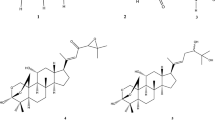Abstract
The structure of C16H10N4O4[HCl,1.5CH3OH], Mr = 406.80, has been determined from X-ray diffraction data. The crystals are monoclinic, space group C2/c, with eight molecules per unit cell and a = 21.482(4), b = 7.131(1), c = 24.495(5) Å, β = 111.01(3)°, crystal density Dc = 1.546 g/cm3. The material was difficult to crystallize and crystals produced were found to be poor diffractors. Intensity data were measured at liquid nitrogen temperature using a weakly diffracting crystal typical of the batch. However the X-ray analysis has finally enabled the chemical constitution of this cryptolepine derivative, which was previously incorrectly assigned, to be unequivocally established. Direct methods were used to solve the structure which was refined by full-matrix least squares to a conventional R-index of 0.0798 for 2,861 reflections and 268 parameters. The 7,9-dinitrocryptolepine molecule is highly planar with a strong intramolecular hydrogen bond between N(10) in ring C and O(92) of a nitro group. There are a number of intermolecular hydrogen bonds involving the cryptolepine derivative the hydrochloride and both solvated methanols. One of the methanol solvate molecules (methanol 2) is unusually disordered with its C atom lying exactly on a crystallographic twofold axis. Consequently the methanol OH and H3 groups are at 0.5 occupancy and repeated by the twofold symmetry.
Graphical Abstract
Cryptolepine (5-methyl, 10H-indolo[3,2-b]quinoline) the principal constituent of Cryptolepis sanguinolenta (Periplocaceae) is currently of interest as a lead compound for the development of both antimalarial and anticancer agents. Cryptolepine has potent activity against malaria parasites in vitro, but it is also cytotoxic on account of its abilities to intercalate into DNA, inhibit DNA synthesis and inhibit topoisomerase II. The 7,9-dinitroanalogue of cryptolepine was synthesised as part of a program designed to discover new antimalarial and anticancer agents. The X-ray structure of this compound will help to determine whether or not 7,9-dinitrocryptolepine is able to intercalate into DNA and facilitate the design of new cryptolepine analogues with DNA binding properties appropriate for antimalarial (with no DNA intercalation) or anticancer (sequence-specific binding) applications.






Similar content being viewed by others
References
Wright CW, Addae-Kyereme J, Breen AG, Brown JE, Cox MF, Croft SL, Gokcek Y, Kendrick H, Phillips RM, Pollet PL (2001) J Med Chem 44:3187
Bonjean K, De Pauw-Gillet MC, Defrense MP, Colson P, Houssier C, Dassonneville L, Bailly C, Greimers R, Wright CW, Quentin-Leclercq J, Tits M., Angenot L (1998) Biochemistry 37:5136–5146
Lisgarten JN, Coll M, Portugal J, Wright CW, Aymami J (2002) Nat Struct Biol 9:57–60
Delvaux EJ (1931) J Pharm Belg 13:973
Hooft R (1998) Nonius B.V. COLLECT: X-ray data collection and processing software user interface
Cosier J, Glazer AM (1986) J Appl Cryst 19:105
Oxford Molecular (1999) http://www.oxmol.com:Chem-X
Otwinowski Z, Minor W (1997) Methods in enzymology, 276. In: Carter CW Jr, Sweet RM (eds) Macromolecular crystallography, Part A. Academic Press, NY, pp 307–326
Blessing RH (1995) Acta Cryst A51:33
Blessing RH (1997) J Appl Cryst 30:421
Sheldrick GM (1986) SHELX86, program for crystal structure determination. University of Göttingen, Germany
Sheldrick GM (1997) SHELX97, program for crystal structure refinement. University of Göttingen, Germany
Farrugia LJ (1999) J Appl Crystallogr 32:837
Farrugia LJ (1997) In Johnson CK, Burnett MN (ed) Based on ORTEP-III (v 1.0.3). J Appl Cryst 30:565
Merrit EA, Bacon DJ (1997) Raster 3D graphics version 2.7c. Methods in enzymology 277, 505 (implemented in WinGX (qv) and generated by Ortep-3 for Windows)
Macrae CF, Edgington PR, McCabe P, Pidcock E, Shields GP, Taylor R, Towler M, van de Streek J (2006) J Appl Cryst 39:453
Wright CW, Philipson JD, Lisgarten JN, Palmer RA (1999) J Chem Cryst 29:449
Lisgarten JN, Potter BS, Palmer RA, Pitts JE, Wright CW (2008) J Chem Cryst. doi:10.1007/s10870-008-9398-7
Author information
Authors and Affiliations
Corresponding author
Rights and permissions
About this article
Cite this article
Lisgarten, J.N., Potter, B.S., Palmer, R.A. et al. Structure of the Antiplasmodial Compound 7,9-Dinitrocryptolepine Hydrochloride Methanol Solvate. J Chem Crystallogr 38, 815–819 (2008). https://doi.org/10.1007/s10870-008-9397-8
Received:
Accepted:
Published:
Issue Date:
DOI: https://doi.org/10.1007/s10870-008-9397-8




